India, with its growing urbanisation, is emphasising on achieving its target of 100% safe water coverage and advancing utilities toward smart water management.
By Dilip Sharma, Senior Advancement Manager – South Asia, Bentley Systems
Water is a major life force for the planet earth and human beings. Though it is available in abundance on earth, the availability of usable fresh water is limited. The irresponsible human attitude towards water resource usage has taken it to a stage where freshwater availability has become questionable, and we just cannot rely on traditional ways of managing and conserving water as a resource.
Water distribution network is an integral part of any civilisation, ancient or modern. In fact, history has enough evidence to prove that the best-planned cities in ancient times had planned and efficient water distribution networks along with the best available management practices. Mohenjo-Daro, one of the best cities of the Indus Valley Civilisation, dated way back in the third millennium BC has used one of the most advanced systems for supplying water and managing wastewater.
Hence, it is of paramount importance and utmost need of time for any urban city to not just build a robust water infrastructure but also to have the best available management practices and tools to achieve operational excellence over its process.
Water resources in India are under stress due to a high groundwater withdrawal rate. The availability of safe drinking water is not sufficient to cater to its population demand. Ageing water infrastructure and poorly managed utilities are some of the challenges that India looks to overcome. This is where government schemes such as AMURT 2.0, JJM (Urban), and JJM (Rural) aim to provide safe drinking water to every household.
The nation is also focusing on upgrading its water infrastructure from an existing intermittent supply to a continuous 24×7 water supply under the AMRUT 2.0 initiative. New pipelines are being laid and the old ones are being revamped. Public Private Partnership model has been brought in place to bring in expertise and accelerate the work.
Technology has always played an important role in the transformation of any sector, and the water sector in India is also looking out for solutions to make its utilities smarter and better. Digital technologies that use advanced tools, analytics and technology are being tested for adoption. A lot of pilot-scale trials are being undertaken in the country to test it feasibility with the ongoing schemes.
Bentley Systems has been a known name in the infrastructure world for its innovative and purposeful software solutions for project deliveries. WaterGEMS and SewerGEMS are water infrastructure softwares that have helped India and the world to design some of the most complex systems, way before their project deadlines.
Envisaging the need of the hour and with an aim to provide best-in-place operation and maintenance practices to the water distribution networks, Bentley has come up with its Digital Twin technology for a water distribution network called WaterSight. WaterSight leverage on Bentley’s open cloud-based iTwin platform to provide integration on various software system in one place. It gives a single view of truth to many stakeholders by creating a digital line of sight.
Digital Twin can be defined as a virtual or dynamic digital representation of a system or process technology with engineering information to model its performance. WaterSight combines SCADA/IoT, GIS, hydraulic modelling, and customer information such as billing data etc. into a single, interoperable dashboard. It delivers a utility-wide view into the detection of critical system and individual asset performance information, enabling more efficient operations and maintenance planning decisions.
With the help of Artificial Intelligence, machine learning and predictive analytics, it can forecast future demands and provide other helpful insights to manage any utility much smartly than ever before. It covers the entire lifecycle of the water supply network from its planning stake to the operations & maintenance stage along with stakeholder engagement like collecting feedback from consumers or managing the event logs through its issue resolution service.
For Indian utilities, WaterSight is capable of performing:
• Water audit and NRW management (System wise/ zone wise (DMAs or pressure zones)/month-wise). Monitor and report on real losses and apparent losses.
• Leak identification and localisation.
• Energy management, tracking and simulating Pump performance and CO2 footprint tracking.
• GIS-based asset tracking (pump house, pumps, valves, smart meters, flow meters, pressure loggers and any other devices with IoT sensors in the network).
• Water quality monitoring
• Real-time monitoring and simulation of GIS-based hydraulic model live on the web page to get real-time visibility and insights of the system: such as flows and pressures, network asset details, sensor details, water quality and SCADA data with predictive forecast backed up by AI/ML.
• Network monitoring of sensors and zones (DMA areas). The sensor data is directly fed to the real-time hydraulic model which is auto-adjusted using real demands and consumptions.
• Monitor tank levels and tank turnover time.
• Risk analysis of the network assets using probabilistic approach that can be used for capital planning and improvement of the network and better inspections and maintenance strategies.
A few examples of how digital twins are solving real business problems of the world are:
Evides, Netherlands
The main goal of this water company is a safe and secure water supply to the City of Rotterdam. Their digital twin project contributed towards sustainable water supply, energy efficiency, and advancement towards CO2 net zero goal by 2025.
AEGEA, Brazil
It is one of Brazil’s largest private water and sanitation companies, which serves more than 21 million people in 153 cities across the country. Their goal was to improve leak detection and prevent pipe bursts for Manaus—the capital and largest city of the Brazilian state of Amazonas, which is the home of 2 million residents. They integrated data in different systems into one single platform, providing additional insights. Typical non-revenue water improvements are 10-20%.
DC Water, USA
The USA turned to Bentley’s OpenFlows digital twin to make data and analytics more visible across the enterprise, reduce operational and capital expenditures, and reduce non-revenue water loss. They integrated hydraulic models with real-time SCADA data to improve calibration and pipe break response and mitigation. The browser-based hydraulic model makes data available to different business functions across the utility to improve their response to service disruptions.
Agua e Energeia do Porto, Portugal
Agua e Energeia do Porto in Portugal integrated data from over 20 software systems into one smart water platform. With improved operational decision making, they reduced supply interruptions by 22% and non-revenue water by 3.6% and improved customer service.
Shimla and Shirpur, India
India, with its growing urbanisation, is emphasising on achieving its target of 100% safe water coverage and advancing utilities toward smart water management. India’s water sector must use advanced technologies to not just build infrastructure but also to gain operational excellence in their process. With the kind of capabilities that Digital Twin possesses, the usage of this technology can certainly reap early benefits to its adopters, such that we demonstrated with pilot projects implementation for City of Shimla and City of Shirpur. We are excited to implement this digital twin technology for many cities and provinces in India for the benefit of its people.
ABOUT THE AUTHOR
Dilip Sharma is a business leader in the field of water & wastewater management and utilities with more than a decade long experience across the industry. He has worked with his users at the grass-root level to help them achieve operational excellence, TCO (Total Cost of Ownership) savings and helped them reduce water footprints and energy usage. Dilip is now leading business development of the water solutions software for India and South Asia regions at Bentley.
To know more about the author, kindly write to us at info@thewaterdigest.com
Click here to read this complete issue of Digest Magazine XVI-IV.














